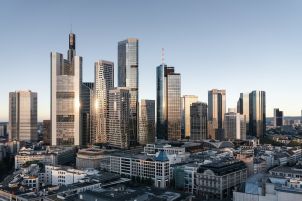The circular economy, in its broader meaning, encompasses everything from materials management to the reuse of infrastructure, while also promoting shared use and short supply chains. These practices help to reduce waste, optimise resource use and foster more responsible consumption. By reusing existing structures and by sharing spaces, we contribute to sustainability and maximise benefits – whether environmental, social or economic.
If we look at materials, the construction sector in France generates around 46 million tonnes of waste, half of which comes from demolition sites*. Limiting this waste and transforming it into resources through reuse and the circular economy is one solution for creating resilient, low-carbon cities.
This approach, which leverages waste and recognises the value of reusing materials, encourages the use of existing resources and reduces the consumption of raw materials. This new mindset turns buildings into stores of materials and reservoirs of resources. Reusing what already exists instead of buying new is a philosophy with a tangible impact. For an area of 1,000 m², reusing materials can save:
- 44 tonnes of waste
- 67 tonnes of CO2 equivalent emissions
- more than a million litres of water.**
The 3 Rs: “Reduce, Reuse, Recycle”
The circular economy, or how to recover real estate waste
In response to the environmental impact of construction, an increasing number of property developers are turning to the circular economy. In this approach, waste becomes a product for (re)consumption. At the end of its first life, waste is recycled to be incorporated into a building where it finds a new purpose, extending its lifespan and adding value to its original production.
In Neuilly-sur-Seine, along the corridor that links Paris to the La Défense business district, the office building at 185 Avenue Charles de Gaulle has undergone an ambitious renovation. BNP Paribas REIM, in line with its ESG strategy, envisioned a large-scale renovation for this property, owned by its Accès Valeur Pierre SCPI investment vehicle, conducted through an exemplary worksite.
Circular economy principles were applied during the demolition, allowing various materials from the former building to be reused in other renovation projects:
- 17,000 m² of carpeting for the World Trade Center project in Belgium
- 95 tonnes of metalwork for the Industrial Museum in Rouen
- 500 doors
- a generator unit
- sanitary fixtures (sinks, taps) and furnishings.
A careful methodology enabled the recovery and reuse of 97% of the demolition waste.
For the renovation work, the target of zero ultimate waste was achieved through measures such as setting up an on-site waste management facility, prefabricating sanitary blocks, using reclaimed materials and recycled paints, and incorporating low-carbon concrete. These efforts led to a 33% reduction in CO2 emissions compared to a conventional renovation project.
Environmentally-friendly real estate concept
Incorporating reused materials requires a dedicated logistics process. Careful dismantling and proper packaging are essential to maintain the quality of the product. When kept in good condition, these materials eliminate the need for new products, which would otherwise involve resource extraction, the consumption of energy for production and carbon dioxide emissions from transportation.
One of the auditoria at METAL 57 in Boulogne-Billancourt was designed in line with principles of the circular economy. To achieve this, BNP Paribas Real Estate partnered with Kataba, a social enterprise specialising in ethical furniture manufacturing. The eco-design of this space emphasised the reuse of materials and the selection of refurbished equipment, in particular audiovisual systems. Nine people on a work integration scheme contributed to the project, promoting a sustainable approach to interior design.
This initiative successfully reused 874 kg of materials and saved 6.8 tonnes of CO2 equivalent emissions, reducing the carbon footprint by five times compared to a conventional project of the same scale.


The Agora demonstrates the harmony between the circular economy, comfort and aesthetics. In designing this 120 m² space, BNP Paribas Real Estate aims to show clients and partners that an environmentally friendly alternative is possible. We extended this approach to the design of CXC, a hub for innovation exchange, and continue to advocate for thoughtful and refurbished designs.

FURTHER READING: BNP Paribas Real Estate’s low-carbon project
Building renovation: An endless source for reuse
Transforming waste into resources
Reuse is a powerful tool for sustainable real estate. Ideally, modern construction projects should be designed with future demolition in mind in order to maximise the reuse of materials. While waiting for such forward-thinking construction practices to become the norm, other innovative methods are being trialled, such as construction using recycled materials.
One notable example is the Senckenberg Tower in Frankfurt, renovated by BNP Paribas Real Estate and featuring a façade made of 95% recycled aluminium. It is the tallest building in Germany to use this material. The figures reveal the progress and environmental benefits: producing 1 kg of primary aluminium in Europe emits an average of 8.6 kg of CO2, whereas 1 kg of recycled Hydro Circal*** aluminium emits only 2.3 kg – a 75% reduction in greenhouse gas emissions. The use of recycled aluminium has helped reduce the building’s carbon footprint by over 2,600 tonnes of CO2.
It is a challenge to standardise reuse practices because each real estate project has unique characteristics. The condition of the building and a detailed, case-by-case assessment are essential for identifying resources and opportunities. In Paris, the office building at 47 Quai d’Austerlitz, owned by the SCPI Accimmo Pierre, managed by BNP Paribas REIM, is undergoing a renovation with a strong emphasis on reuse to minimise the environmental impact. This 20-year-old building has been well maintained by its long-standing tenant, making a “careful dismantling” process possible, which has facilitated the recovery via reuse of nearly 400 tonnes of materials (such as cable trays, carpeting and raised flooring), equivalent to nearly 900 tonnes of CO2 equivalent. This represents roughly 15% of the project’s waste.
The project also plans to retain the exterior window frames, which are still efficient, preserving 15 to 20% of the existing frames. Additionally, all raised flooring panels that are in a good condition will be refurbished and reused on-site. Some still-functioning technical systems (backup generators, emergency chillers, transformers) will also be kept. This project is part of an ambitious environmental programme aiming for multiple certifications and labels, ensuring the building surpasses the 2040 Tertiary Decree standards by 2026 and achieves the new mixed-use BBCA (Low-Carbon Building) benchmark.

FURTHER LISTENING: Real Catch Up: Building differently, through the lens of the circular economy
Collective effort to promote circularity
Industrialising reuse and the circular economy in real estate requires the engagement of all professionals across the value chain.
Collaborative efforts are essential to jointly define how potential resources from building renovations are recycled and to establish appropriate supply chains. BNP Paribas Real Estate is a partner of CircoLab, a circular economy think tank that advocates for renovation, repair and reuse in order to:
- extend the lifespan of materials and reduce the consumption of raw materials at source
- encourage the recycling of waste to supply raw material resources.
BNP Paribas Real Estate is also part of the Booster du Réemploi initiative, which aims to reduce the carbon footprint of the construction sector by 20 to 30% through the reuse of materials. Its platform connects suppliers and users interested in reused materials.
The circular economy and reuse are challenging the economic models promoted in recent decades. While initial costs for these practices may be higher, they can prove profitable over the long term. Nonetheless, there remain many challenges to be tackled, including regulatory, construction and insurance-related obstacles. Inspiring urban stakeholders to adopt these environmental approaches is vital. Raising awareness will encourage the entire real estate sector to promote the approach and integrate principles of the circular economy into its projects. Only through collective participation and investment can developers, architects and companies work together to build sustainable cities.





